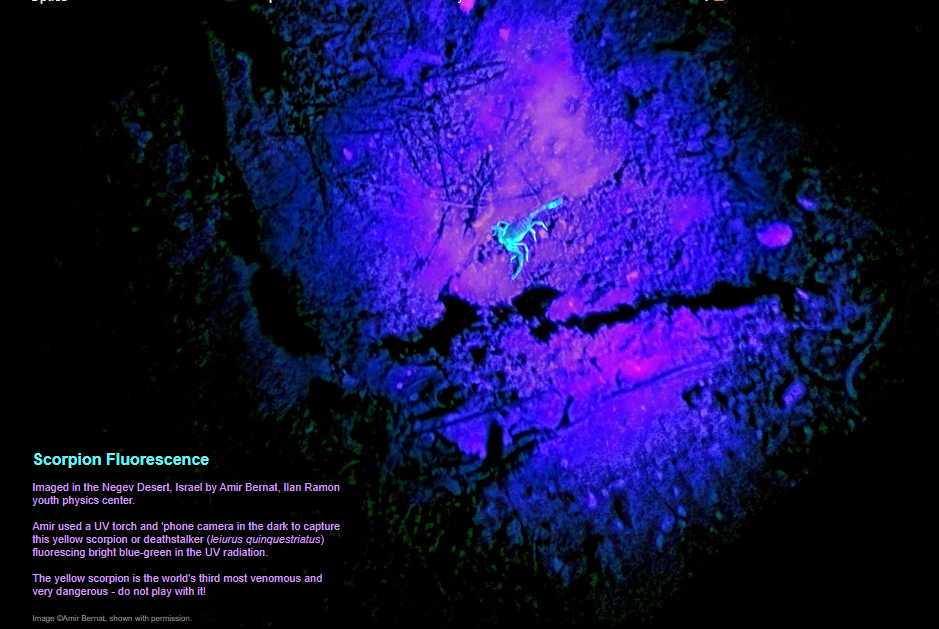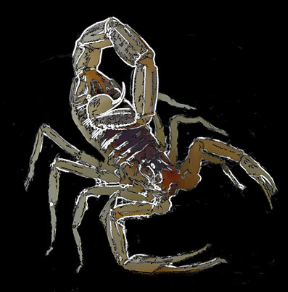Scorpion Fluorescence - OPOD
Scorpion Fluorescence: A Fascinating Natural Phenomenon
Scorpions, with their menacing appearance and venomous stings, have long been a source of intrigue and fear. But did you know that these nocturnal creatures possess a remarkable ability to fluoresce under ultraviolet (UV) light? In this article, we delve into the captivating world of scorpion fluorescence and explore the science behind this phenomenon.
Unveiling the Glow
When exposed to UV light, scorpions emit a vibrant blue-green glow. This fluorescence is most commonly observed in the carapaces, or exoskeletons, of these arachnids. Although the exact purpose of this fluorescence remains uncertain, scientists speculate that scorpions can detect the emitted light, acting as a whole-body light collector. This ability may help them determine if any part of their body is exposed to the night sky or moon, alerting them to potential predators or revealing their location to potential prey.
The Science Behind Scorpion Fluorescence
Fluorescence occurs when a molecule or crystal lattice absorbs short-wavelength radiation and becomes electronically excited. The absorbed energy can either be dissipated through collisions or other transfer routes, or it can be radiated away through an electronic transition to a lower energy state. In the case of scorpions, their carapaces absorb UV light and re-emit it as longer-wavelength blue-green light, resulting in the mesmerizing fluorescence we observe.
Phosphorescence, a similar phenomenon to fluorescence, differs in the timescale of light emission. In phosphorescence, the absorbed energy is transferred to electronic states with very long radiative lifetimes, leading to delayed emission. Chemiluminescence, on the other hand, involves a chemical reaction that generates an excited state molecule. This molecule then radiates the excess energy or transfers it to another dye molecule.
The Fascination of Fluorescence
Fluorescence is not limited to scorpions; it can be observed in various contexts, both natural and artificial. Stepping into a dark room illuminated by UV lamps, one may witness teeth glowing blue-white, freshly laundered white shirts shining with an unnatural blue-white hue due to detergent whiteners, and even certain minerals and gemstones displaying new colors.
Bioluminescence: Nature's Illumination
While chemiluminescence is primarily associated with chemical reactions, bioluminescence is a captivating form of chemiluminescence exhibited by living organisms. In bioluminescence, light production is driven by the oxidation of a molecule known as luciferin, catalyzed by a specific enzyme called luciferase. Fireflies, squids, jellyfish, and even certain bacteria found in the milky sea are among the many creatures that harness the power of bioluminescence.
In conclusion, scorpion fluorescence is a mesmerizing natural phenomenon that adds to the mystique surrounding these intriguing arachnids. While the exact purpose of their fluorescence remains a subject of scientific investigation, it is clear that scorpions possess a unique ability to emit a brilliant blue-green glow when exposed to UV light. This phenomenon showcases the beauty and diversity of nature's optical wonders and reminds us of the countless mysteries that continue to unfold in the world around us.

Scorpion Fluorescence
Imaged in the Negev Desert, Israel by Amir Bernat, Ilan Ramon youth physics center.
Amir used a UV torch and 'phone camera in the dark to capture this yellow scorpion or deathstalker (leiurus quinquestriatus) fluorescing bright blue-green in the UV radiation.
The yellow scorpion is the world's third most venomous and very dangerous - do not play with it!
Image ©Amir Bernat, shown with permission.

Scorpions
Scorpions like to shelter and hide.
The carapaces of most if not all of them fluoresce blue-green when illuminated by ultra violet light. It is thought, but not known for certain, that they can sense the fluorescence so that they have in effect a whole body light collector to tell them when any part of them is unhidden and exposed to the night sky or moon.
Scorpions with their many eyes masked still start to scurry about when lit by UV radiation (395nm). The UV is converted by fluorescence to cyan-green light which is then presumably detected by receptors in the carapace.
Fluorescence and more..
Go into an otherwise dark room illuminated by ultra-violet lamps. Teeth glow blue-white. Freshly laundered white shirts shine unnaturally blue-white with detergent whiteners. Some paper but not a banknote looks over-bright. Many minerals and gemstones have new colours.
A molecule or crystal lattice is absorbing short wave radiation and becoming electronically excited. Two things can happen, the extra energy might be dissipated by collisions or other transfer routes (quenching) or it can be radiated away by an electronic transition to a lower energy state. The re-emitted radiation or fluorescence is usually � but not always � at longer (lower energy) wavelengths. Thus scorpion carapaces absorb short wavelength UV and fluoresce in longer wavelength blue-green.
Phosphorescence is essentially fluorescence except that the light emission occurs over a longer timescale. The absorbed energy is transferred to electronic states which have very long radiative lifetimes because the necessary transitions for re-radiation are not allowed (forbidden in quantum mechanical parlance). The stored energy is eventually transferred to other states that are able to radiate and the delayed emission is phosphorescence.
Chemiluminescence is quite different. A chemical reaction generates a new molecule in an excited state. The extra energy is then radiated away or is transferred to a another (dye) molecule that does so.
Bioluminescence � the production of light by living things � is mostly a form of chemiluminescence from the oxidation of a molecule labelled a luciferin and catalysed by a specific enzyme (a luciferase). There are a whole variety of luciferin molecules that specifically power fireflies, squids, jellyfish, milky sea bacteria and more.
Note: this article has been automatically converted from the old site and may not appear as intended. You can find the original article here.
Reference Atmospheric Optics
If you use any of the definitions, information, or data presented on Atmospheric Optics, please copy the link or reference below to properly credit us as the reference source. Thank you!
-
<a href="https://atoptics.co.uk/blog/scorpion-fluorescence-opod/">Scorpion Fluorescence - OPOD</a>
-
"Scorpion Fluorescence - OPOD". Atmospheric Optics. Accessed on April 18, 2024. https://atoptics.co.uk/blog/scorpion-fluorescence-opod/.
-
"Scorpion Fluorescence - OPOD". Atmospheric Optics, https://atoptics.co.uk/blog/scorpion-fluorescence-opod/. Accessed 18 April, 2024
-
Scorpion Fluorescence - OPOD. Atmospheric Optics. Retrieved from https://atoptics.co.uk/blog/scorpion-fluorescence-opod/.